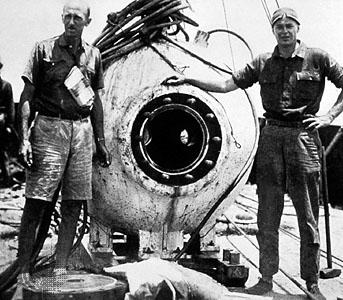UNL had the pleasure of hosting Dr. Stacy Alaimo’s March 28th presentation, dubbed “Deep Sea Speculations: Literature, Art, & Science in the Abyss”, for the Robert E. Knoll lecture this spring. The premise of this lecture was how the aesthetic of the deep sea circulates in the realms of literature, art, and science, and could that aesthetic be considered political. Alaimo pointed out that deep seas have always provoked modes of surreal speculation, and her talk circulated throughout the roles both the humanities and the STEM fields have played in these speculations and the bafflement that has historically been associated with deep seas and deep sea discoveries.
Dr. Alaimo’s presentation first gave background to the earliest explorations of the deep sea, done by naturalist William Beebe and inventor Otis Barton in Barton’s invention of the bathysphere. The bathysphere was a metal sphere with two portholes, with just enough room for the two men to crouch together as they made over 30 descents into depths of the ocean.

Beebe wrote over 800 articles and 24 books, and in those that focused on his work in the sea, Alaimo made clear that there was a deep intertwining of science and aesthetic in Beebe’s work. During the bathysphere dives, he would comment on the depths he and Barton reached; at 600 feet below the surface, he noted, “Only dead men have sunk below this.” He described luminescent fish and compared them to the stars, drawing frequent parallels between the depths of the oceans and the voids of space.
Transitioning to the realm of art, Alaimo used Beebe’s colleague Else Brostelmann, who illustrated the creatures Beebe described from his dives. Her productions were published by National Geographic, and of them Alaimo had to say, “The art brings the depths into the human world while conveying they are outside of human translation.”
The literature that Dr. Alaimo concluded the lecture with was the 1953 science fiction novel The Kraken Wakes, by John Wyndham. It is a narrative propelled by the bafflement of the amorphous creatures in the deepest parts of the oceans, and can be read as a lack of wonder and inability to interact with the surreal, according to Alaimo.
Concluding her lecture, she makes the point that in order to sustain blue ecology and halt the devastation currently being done to our seas, we need both the reason of science and the creativity of the humanities. Humanists can communicate the message of sustainability with the logos of scientists and their own pathos, drawing the ethos of their arguments from both sides of these disciplines. This message echoes what several digital humanists have mentioned in past class readings, and such reinforcement should be seen as an indicator that there is value to all sides of human exploration.
**Posted for extra credit
Sources:
https://www.britannica.com/science/bathysphere (Bathysphere image)
https://www.natgeocreative.com/photography/elsebostelmann (Bostelmann eel illustration)
http://www.stevenkasher.com/exhibitions/national-geographic-the-past-and-future-present (Bostelmann fish image)

No comments:
Post a Comment